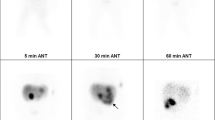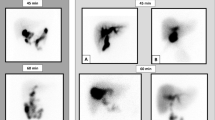Abstract
Hepatobiliary scintigraphy has been widely used for the differential diagnosis of neonatal cholestasis. Relatively good hepatic uptake with no evidence of excretion into the bowel for up to 24 h is a representative finding of biliary atresia. Hepatobiliary scintigraphy has very high sensitivity and moderate specificity. Here, we report a false-positive case of hepatobiliary scintigraphy in a child with a choledochal cyst, which mimicked biliary atresia.




Similar content being viewed by others
References
Gotze T, Blessing H, Grillhosl C, Gerner P, Hoerning A. Neonatal cholestasis - differential diagnoses, current diagnostic procedures, and treatment. Front Pediatr. 2015;3:43.
Anand SS, Handa RK, Singh J, Sinha I. Hepato-biliary scintigraphy in diagnosis of biliary atresia. Med J Armed Forces India. 2006;62:20–1.
Howman-Giles R, Uren R, Bernard E, Dorney S. Hepatobiliary scintigraphy in infancy. J Nucl Med. 1998;39:311–9.
Bhavsar MS, Vora HB, Giriyappa VH. Choledochal cysts : a review of literature. Saudi J Gastroenterol. 2012;18:230–6.
Todani T, Watanabe Y, Narusue M, Tabuchi K, Okajima K. Congenital bile duct cysts: classification, operative procedures, and review of thirty-seven cases including cancer arising from choledochal cyst. Am J Surg. 1977;134:263–9.
Khandelwal C, Anand U, Kumar B, Priyadarshi RN. Diagnosis and management of choledochal cysts. Indian J Surg. 2012;74:401–6.
Tan Kendrick AP, Phua KB, Ooi BC, Subramaniam R, Tan CE, Goh AS. Making the diagnosis of biliary atresia using the triangular cord sign and gallbladder length. Pediatr Radiol. 2000;30:69–73.
Kirks DR, Coleman RE, Filston HC, Rosenberg ER, Merten DF. An imaging approach to persistent neonatal jaundice. AJR Am J Roentgenol. 1984;142:461–5.
Schooler GR, Mavis A. Cystic biliary atresia: a distinct clinical entity that may mimic choledochal cyst. Radiol Case Rep. 2018;13:415–8.
Zhou LY, Guan BY, Li L, Xu ZF, Dai CP, Wang W, et al. Objective differential characteristics of cystic biliary atresia and choledochal cysts in neonates and young infants: sonographic findings. J Ultrasound Med. 2012;31:833–41.
Kim WS, Kim IO, Yeon KM, Park KW, Seo JK, Kim CJ. Choledochal cyst with or without biliary atresia in neonates and young infants: US differentiation. Radiology. 1998;209:465–9.
Fatahi N, Mohammadipoor A, Malekmarzban A. Extra hepatic biliary atresia associated with choledochal cyst: a challenging neonatal obstructive jaundice. J Neonatal Surg. 2014;3:20.
Torrisi JM, Haller JO, Velcek FT. Choledochal cyst and biliary atresia in the neonate: imaging findings in five cases. AJR Am J Roentgenol. 1990;155:1273–6.
Author information
Authors and Affiliations
Corresponding author
Ethics declarations
Conflict of Interest
Il-Hyun Kim, Young-Sil An, Su Jin Lee, Jeong Hong, and Joon-Kee Yoon declare that they have no conflict of interest.
Ethical Approval
All procedures performed in studies involving human participants were in accordance with the ethical standards of the institutional research committee and with the 1964 Helsinki declaration and its later amendments.
Informed Consent
The institutional review board of our institute approved this study, and the requirement to obtain informed consent was waived.
Additional information
Publisher’s Note
Springer Nature remains neutral with regard to jurisdictional claims in published maps and institutional affiliations.
Rights and permissions
About this article
Cite this article
Kim, IH., An, YS., Lee, S.J. et al. Hilar Choledochal Cyst Mimicking Biliary Atresia on Hepatobiliary Scintigraphy: a Case Report. Nucl Med Mol Imaging 55, 96–99 (2021). https://doi.org/10.1007/s13139-021-00688-5
Received:
Revised:
Accepted:
Published:
Issue Date:
DOI: https://doi.org/10.1007/s13139-021-00688-5




